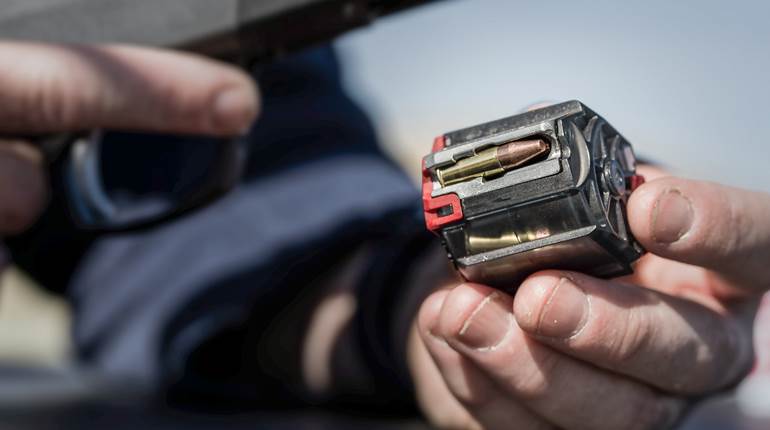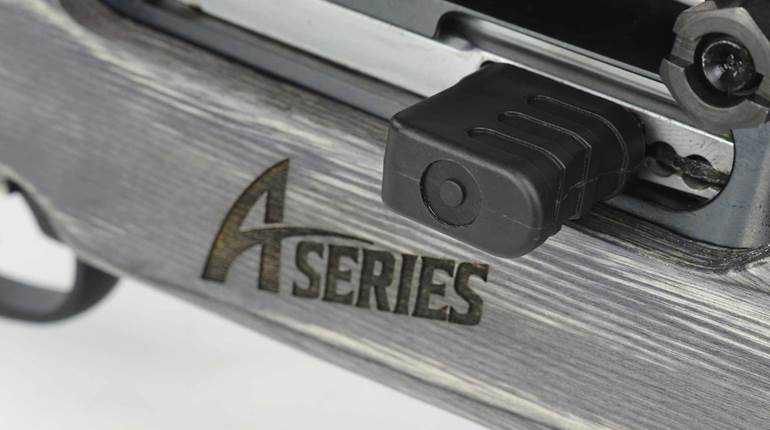
One of the universal truths in life is, according to virtually every U.S. serviceman, their rifle is too darned heavy. The 1873 Trapdoor Springfield with its 32 5/8" barrel weighed in at more than 8 2/3 lbs.; its successor was about the same. Famous for its accuracy and durability, the 1903 Springfield tipped the scales nearly identically, and the really famous and lauded M1 Garand cut into a soldier’s shoulder with 9 1/2 to 11 1/2 lbs. of mass. For a frontline trigger puller, that kind of mass is welcomed when the fire must be accurately placed for a sustained period of time. But for the guys in the rear with the gear, such a weight is burdensome and cumbersome—so much so that it can adversely affect their abilities to do their job.
All that grumbling finally caught an ear with military brass, and in 1938 the Chief of Infantry requested that the Ordnance Department develop a light rifle or carbine. The idea was to develop an arm handier than a battle rifle, yet more powerful and accurate than a handgun with an effective range of 300 yards so that support troops could defend themselves in the event of a surprise attack. It would be another two years before the authorization to research and produce a prototype would occur.
Winchester sort of yawned toward the carbine idea; concentrating its efforts with Jonathan “Ed” Browning, half-brother of the famous firearm designer John Browning, to produce an M2 variation of the Garand chambered in .30-06. Browning died suddenly in 1939, and two months later Winchester hired David Marshall Williams to pursue the carbine project.
Williams, who was born in the backwoods of North Carolina, had a checkered record with several run-ins with the law, culminating with the murder of Sheriff Alfred J. Pate on July 22, 1921, during a botched raid of a distillery Williams was running. After pleading down to second-degree murder and operating an illicit distillery, his 30-year sentence was commuted by the North Carolina governor on December 16, 1927, once he was made aware of Williams’ excellent work in the Caledonia State Prison Farm repairing and inventing firearms. It was while he was in prison that Williams developed the floating chamber concept for operating semi-automatic rifles.
This system utilizes the high-pressure gases produced during powder combustion to work on the floating chamber—actually a chamber within a chamber—effectively turning it into a short-recoil piston that drives the bolt rearward to cycle the action. Once Williams was released from prison, he set about patenting his ideas for semi- and automatic firearms. Colt utilized his floating chamber in the Service Ace, a .22 LR training pistol that mimics the 1911 A1 pistol in function, handling and recoil.
A couple of years later, Williams approached the War Department with his floating chamber concept. That demonstration yielded him a contract to modify 1919 Browning machine guns to shoot .22 LR ammunition, saving a lot of money in training, as well as wear and tear on the guns. A short and relatively unproductive stint at Remington followed, and then Williams found full-time employment at Winchester, after Ed Browning’s death and Gen. Julian Hatcher recommending him as the finest natural gunsmith in the country.
Originally, Williams was tasked with completing Browning’s M2 project. Trials conducted in 1940 proved that Ed Browning’s bolt design—locking at the rear and tilting downward as it reciprocated—failed unacceptably in sandy environments. Williams returned to the idea of a Garand-style rotating bolt and incorporated his short-stroke piston. While he was at it, Williams pared down a couple of pounds off the prototype rifle from 9 1/2 to 7 1/2 lbs.
Major René Studler, of Ordnance, and other powers that were soured on the M2 concept decided that the rifle could be further reduced in size and weight and tasked Winchester with developing a prototype. A team of engineers led by Ed Pugsley produced a working prototype in 13 days, essentially adopting Williams’ design and employing a .30 SL prototype cartridge, derived from the .32 SL cartridge in the Model 1905 rifle. Apparently the hastily assembled carbine made a favorable impression, as more samples were ordered for testing and evaluation.
After a couple rounds of testing and refinement, Winchester was informed of the acceptance of the M1 Carbine design in late October 1941. The carbine first saw service in 1942 in the European theatre. During World War II some 6.1 million copies of the M1 Carbine were produced, outpacing the M1 Garand at 5.4 million and well surpassing the Thompson M1 and M1928A1 submachine guns at 1.3 million, making it the most popularly produced long gun of that era. It also garnered the praise of government bean counters for its cost effectiveness. At a unit cost of $45 per copy, it was nearly half the cost of the M1 Garand and about a fifth of the cost of a Thompson.
M1 Paratrooper Carbine
The M1 Carbine was issued to frontline infantry officers, paratroopers and others, and was revered for its accuracy, penetration and portability over the Thompson. It turned out to be widely popular with those whose primary responsibility was administrative than combative. In other words, it was pleasant and unobtrusive to carry, giving a man the comforting—if not accurate—impression that he was well armed, but when the bullets started to fly, the carbine’s luster dimmed because of its ineffectiveness in stopping enemy soldiers.
Problem was the .30 Carbine cartridge was lightweight to carry, thus increasing its firepower—meaning more ammo could be carried by the soldier—but it was equally lightweight in disabling human targets. The cartridge was begat from the .32 SL cartridge. Winchester removed the parent cartridge’s rim, slimmed the case to accept a .308" diameter bullet instead of the original .321" and souped up the muzzle velocity with more modern powders. What they had was a zippier cartridge but smaller in diameter and still saddled with a round-nose, FMJ projectile. It sailed through many obstructions—like Japanese steel helmets—but it also sailed through enemy soldiers and often failed to incapacitate them. Ballistics of the WWII-vintage ammo was 110-gr. FMJ at 1,990 f.p.s. and 967 ft.-lbs. of energy in an 18" barrel. It should be noted that today the use of hollowpoint and soft-point ammunition ups the stopping power of this cartridge a bit. Federal and Winchester load these bullets in the .30 Carbine.
In 1944, a selective-fire version of the M1 Carbine, dubbed the M2, was produced in answer to the German StG 44 rifle (a selective-fire carbine that burdened us with the provocative term “assault rifle”). Concurrent with the M2 development a 30-round magazine was introduced, replacing the original 15-rounders. This variation saw action in both the European and Pacific theatres during those last weeks of the war.
An M3 version was also developed. It featured an M2 infrared “sniper scope” and saw service on Okinawa as well as Korea. While its effective range was limited to 70 yards at night due to the rather infantile infrared technology of the day, the M3 accounted for a majority of the casualties on Okinawa. During the Korean War, the infrared technology improved so that the effective range of the M3 was increased to about 125 yards.
During the early years of the Vietnam War, the M1 Carbine was issued to United States Air Force Security Police and United States Army Special Forces. It was later replaced by the M16 rifle. Thousands more were issued to Vietnamese forces, as well. The M1 Carbine has also seen service in the British, German, Japanese, IDF, French and Philippine militaries. Even more were distributed from surplus to dozens of other countries from around the world.
Surplus sales to U.S. citizens enjoyed a brisk business after WWII, and there are countless versions in collections and safes all over the country. More than two dozen manufacturers have made civilian copies of the M1 Carbine, including Inland Manufacturing today. Collectability of the M1 Carbine has increased to the point that surplus rifles that at one time brought no more than $20 to $25 are now fetching a grand or more.
Despite the motion picture, “Carbine Williams”—MGM 1952—which was a more-or-less biography of David Marshall Williams, he did not have anything more than a few influences in the development and success of the M1 Carbine. Like a lot of things American, the popularity of the M1 Carbine grew more because of imagination than practicality. But it was and remains as American as apple pie.






































